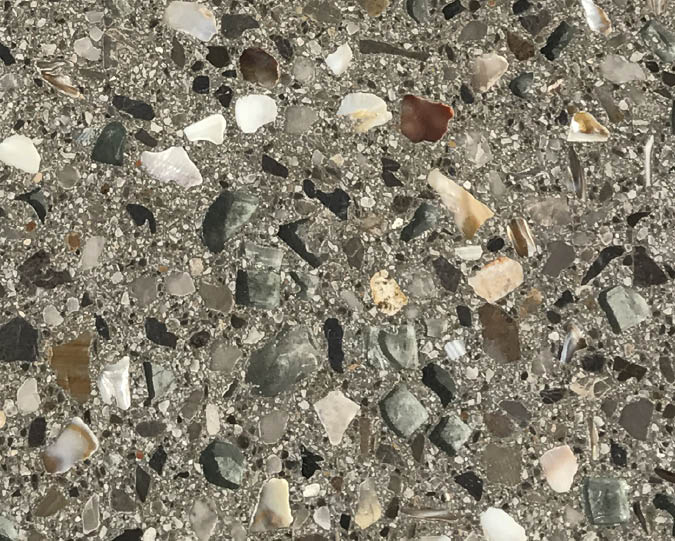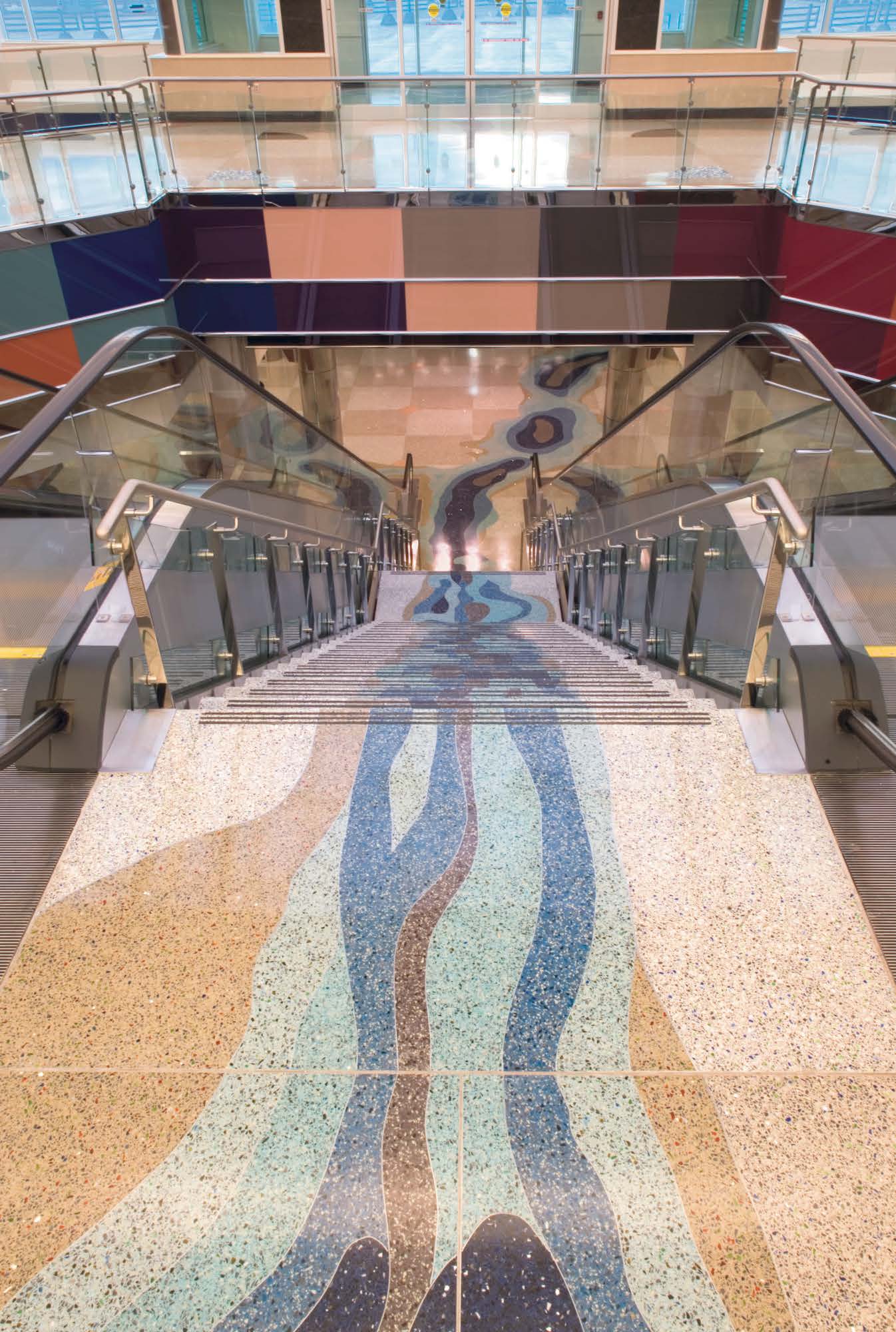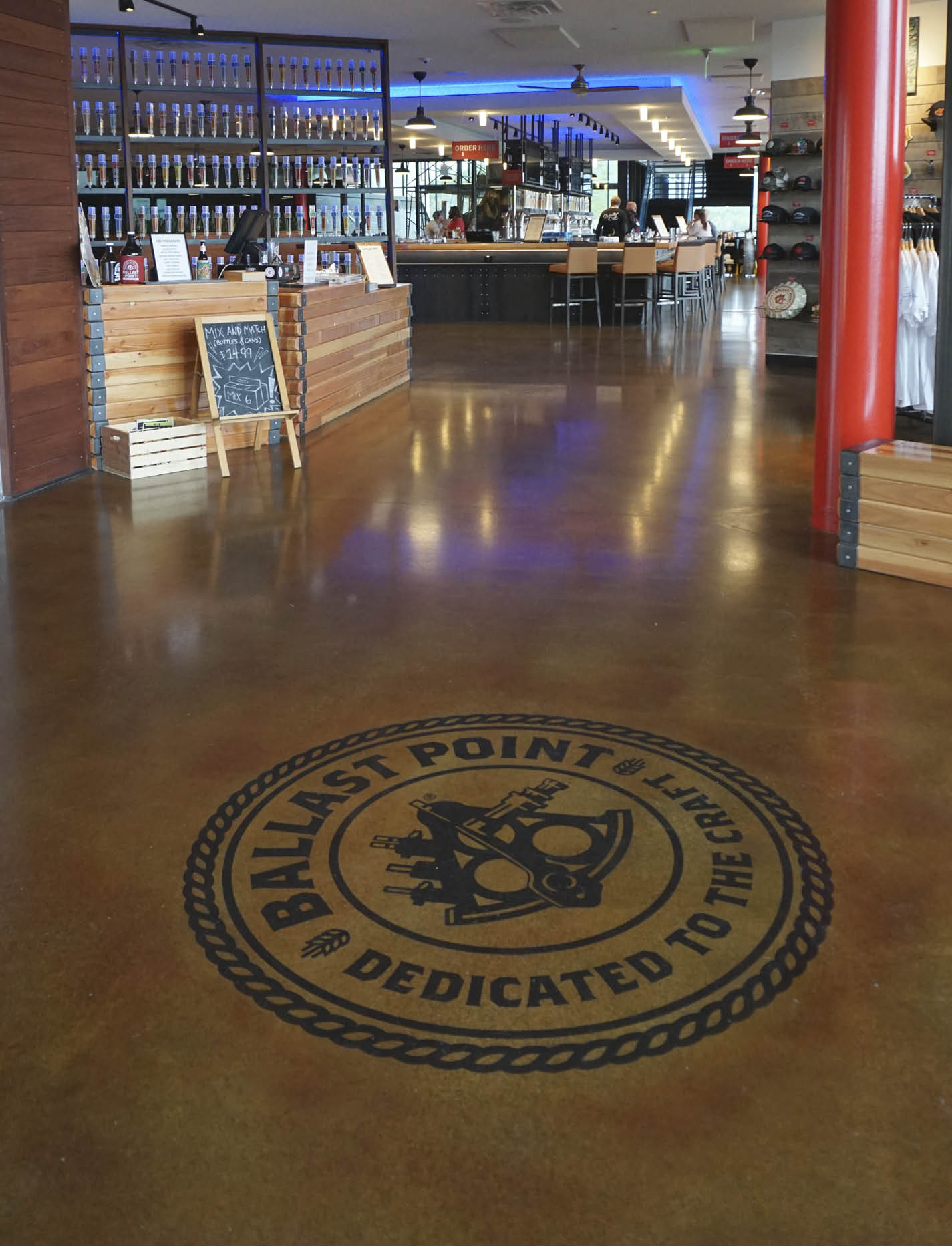
One way to add color to an existing or new slab is to add a touch of glass — or more if you want to make a bolder statement.
Glass aggregates vary in size from 00 (double zero), which measure 1/32 inch to 1/16 inch and smaller, and increase in small increments around 1/8 inch give or take (0, 1, 2 and 3) until the size reaches 1/2 inch to 3/4 inch (4-7). Larger pieces can be custom ordered.

Individual pieces tend to be “angular but chunky,” says Ken Thornley, president of Heritage Glass, a major glass aggregate supplier in Smithfield, Utah, that’s been in business for 40 years. “But they don’t have a sharp edge. You can run your hand through a bag of them without fear of being cut.” Their irregular shape and surface texture help them hold in the concrete, he adds.
His company, as well as competitor American Specialty Glass and others, also sell “jelly beans,” which have rounded edges. Most contractors don’t like this variety as much, he says, because if you grind them more than halfway, pieces tend to pop out.
Because the viewing is closer for countertops, they’re usually seeded with a range of smaller sizes, usually zeros and ones, while flooring and patios typically take the smaller sizes as well as twos and threes.

True blue, true grit
Blue is the most requested color, Heritage’s Thornley continues, as there’s not a natural blue stone that can be used as an aggregate that’s not overly expensive (think precious, semi-precious stones). Clear glass and crushed mirror are also popular choices, while green for some reason is Heritage’s least requested color. As for combinations, red, white and blue win out. All total, the company manufactures about 30 standard colors of glass in powder form up to landscape-rock size.
Thornley says Heritage Glass recycles bottle glass and window glass, melting it down and coloring it with metal oxides so it stays consistent over time. “We’ve been doing it the same way for the past 40 years,” he says.
Glass aggregate is typically broadcast on a wet slab or mixed into a mixture and applied about a 1/2 inch thick. For full coverage, Thornley says you would broadcast 1 pound per square foot or add in 2 pounds per square in a mix. Either way, you’d then grind the surface with anywhere between an 80- and 120-grit diamond.
“Higher than that and it would get too slick for outdoor applications,” Heritage’s Thornley says. For outdoor sidewalks, he recommends using an 80-grit diamond dry and an 80-grit wet. “This will give you slip resistance and the texture you’re looking for.”
He cautions contractors not to grind aggressively when glass is in the mix. “Don’t use a 24-30 grit like you would for stone because the glass will get hot and fracture.”
For interior floors, grinding up to a 200-grit will take out the visual scratches and look great. For countertops, a 1,500-grit is good but, on a floor, Thornley doesn’t recommend going up that high because of the slip factor.
Adding glass to concrete is a wonderful way to add color and depth to a project. “You can look into the glass chips whereas you don’t see into rock,” says Heritage’s Thornley.

Beauty both big and small
Dustin Thornley (no relation to Ken), sales manager for American Specialty Glass in North Salt Lake, Utah — another major glass supplier in the U.S. — adds that clear glass affects the overall look much more than you would think. “Instead of looking at a flat floor, clear glass changes the look. It doesn’t just make the floor shiny. It adds dimension.”
ASG’s Thornley points out that the glass ratio in mixes vary but a typical overlay project will contain 60 percent to 80 percent glass. “A 50-pound bag of overlay usually has 30-40 pounds of glass in the mix. It’s pretty substantial.”
And, he says, be prepared for that much glass to add quite a bit of color as well as dimension.
ASG, he says, both crushes and melts and re-forms its product offerings. He estimates his company — together with his parent company, Strategic Materials — keeps 3 million tons of glass out of landfills each year as it gets the bulk of its product from window and bottle manufacturers.
ASG customers use 00 and smaller as fillers to add recycled content to a mix. “If architects want to add LEED points to a project, they often will specify recycled glass.”
Besides the very small particles, ASG’s Thornley notes, it’s becoming popular to use larger size glass aggregate of 1/2 to 1 inch in size to add variety to projects.
Smashed gets Rocked
One of the industry’s innovators of exposed aggregate decorative concrete, Aggretex Systems has joined forces with Heritage Glass to highlight some incredible combinations possible with their respective products. The Aggretex Smashed line of 19 standard colors can be blended on-site with hundreds of different options from Heritage Glass to create Aggretex Rocked.

Sporting names such as Old Blue Eyes, Judy Garland and Amber Waves of Grain, Rocked “has helped so many designers to make their statement,” says Curt Thompson, Aggretex president and CEO. Both the mix and the glass can be ordered through Aggretex.
“Placed at 3/8-inch thick on freshly poured concrete, Aggretex products are like decorative frosting on a cake,” Thompson says. Smashed and Rocked are placed using Aggretex’s patented wet-on-wet installation methodology. Smashed’s integral color and fine aggregates are blended at the plant to assure consistency from batch to batch.
“You’ll get the same color in the bag every time. No more dealing with color inconsistencies from truck to truck.” Thompson says. “Aggretex is all about delivering consistency, control and predictability in decorative concrete. Contractors can show their clients lots of options depending on color, amount of glass or aggregate, and finish choices from heavy exposure to high polish.”
Floor shine
Another mix that works well with glass aggregate is CTS Cement’s Rapid Set Tru PC, says Scott Kummer owner of Visions Below in Laguna Niguel, California. “Glass is becoming very popular,” he says, and he likes to use it to the tune of 2 pounds of aggregate per foot of Tru PC to create a terrazzo look. “It becomes the artist’s liberation. It’s up to that artist to decide the percentage of glass needed to achieve a finish.”

By its nature, glass comes in a large variety of colors that can be combined to create more finesse to the overall finish. Using a lot of glass in a mix makes for favorable reflectivity, Kummer says. “That’s why it’s used so much in Vegas.
“It definitely defines the attitude for a space such as the Cosmopolitan, for example. It gives you flash. It gives you richness. It gives you that feeling when you walk through the door: This place is in the money.”
Read the original article at https://www.concretedecor.net/departments/concrete-placing/glass-aggregates-dress-up-a-concrete-slab/



